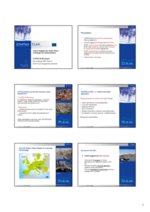Institutional platform for city freight management
Summary
Currently the distribution of goods in Ghent’s city centre is limited to certain timeframes and parking spaces. However, once the dedicated parking spaces are taken, the goods distributors park on the street, causing traffic jams and dangerous situations. By developing discussion platforms, solutions to this situation can be found.
Implementing sustainable mobility
A study in 2004 showed that a classic distribution centre in the city of Ghent is not feasible. As a result, Ghent decided to tackle the problem in another way, focusing on measures and initiatives which facilitate distribution traffic: specific unloading spots, etc. As part of the measure Ghent will develop discussion platforms, which should enable the city to come to a feasible solution to the problem. The installation of the discussion platform will result in the introduction of pilot projects for goods delivery in the city.
Progress
 The objective of this measure is to organise a discussion platform on sustainable goods delivery. At the platform solutions were searched to limit the nuisance of the city distribution of goods. To have more insight at the good distribution in Ghent the City of Ghent participated at the D-Via project, and members of the platform (good distributors and shopkeepers) were enquired. This resulted to a good insight of freight bottlenecks in Ghent.
The objective of this measure is to organise a discussion platform on sustainable goods delivery. At the platform solutions were searched to limit the nuisance of the city distribution of goods. To have more insight at the good distribution in Ghent the City of Ghent participated at the D-Via project, and members of the platform (good distributors and shopkeepers) were enquired. This resulted to a good insight of freight bottlenecks in Ghent.
As the main bottleneck in Ghent is lack and improper use of loading spaces, a pilot project was set up to develop a new type of loading spots around the Vlaanderenstraat.
Outcomes
 Key result 1 - Extra loading spaces added
Key result 1 - Extra loading spaces added
Within the measure a new type of loading spot was introduced in the neighbourhood around the Vlaanderenstraat. In the Brabantdam, two existing B-type sites were converted. Two new locations, Kuiperskaai and Lange Boomgaardstraat, got a new type loading spot. Since 4 new loading spots were introduced around the Vlaanderenstraat, the target was achieved in full.
Key result 2 - Reducing improper use of loading spaces
Before Civitas, a very high abuse rate was found at the existing parking spots dedicated for loading/unloading operations. The increased visibility of the loading spaces and the increased control of the proper use of these spots around the Vlaanderenstraat leads to a reduction of more than 5 times less abuse, so they are always (at least partly) available for loading operations. The target for this measure is exceeded (-80% instead of targetted -20%).
Key result 3 - Platform of city distribution
The City of Ghent experienced a lot of resistance against policy-based solutions for the distribution of goods. As a result, the City of Ghent decided to tackle the problem in another way, focusing on measures and initiatives, which are facilitating life for the distribution traffic: specific unloading spots, etc. After 4 workshops the members of the Platform of city distribution are all positive to very positive about the work that has been done. The target is achieved in full (at least three meetings were targetted).
Key result 4 - Action plan for the nuisances mentioned at the platform
The bottlenecks of freight distribution mentioned in the platform were tackled in the pilot project in the Vlaanderenstraat. The new type of loading spaces around the Vlaanderenstraat solve most of the problems (“Conflicts with trams along the Vlaanderenstraat causes stress”; “Lack and improper use of loading spaces, as there is a high need of loading spaces in this street”, “Fines were distributed when freight vehicles are parked on tram tracks”, “Lack of control of loading spots”). The measure is considered as achieved in full, since a solution for half of the problems was targetted.
Lessons learned
Lessons 1 - Frequent control on the use of loading spots is crucial.
Dedicating parking spots to loading operation will only work if correct use is extorted. In Ghent parking guards check the loading spots twice a day.
Lessons 2 - Free 15 minutes parking ticket facilitates the control.
To facilitate the control, parked delivery vehicle are obliged to get a free ticket with which they are allowed to park for 15 minutes.
Lessons 3 – Differences between ordinary parking spaces and loading spots should be made physically clear
Use of colour is very helpful in this matter. Traffic signs aren’t enough.
Lessons learned 4 – First solve problems and create confidence basis with shopkeepers/distributors at the discussion platform on sustainable goods delivery.









